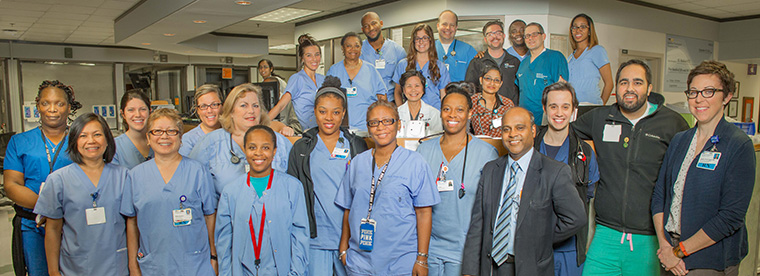Find care now
If you are experiencing a medical emergency, please call 911 or seek care at an emergency room.

CLABSI Free - A Quality & Safety Milestone
This week, Unit 2G, a medical intensive care unit at MedStar Washington Hospital Center, achieved a major milestone: reaching two years without a Central Line-Associated Bloodstream Infection (CLABSI).
Central lines (catheters) are tubes that help patients get the medications or fluids they need and allow medical professional to draw blood for testing. But they also present a particular risk for developing infections, because they are inserted into large veins in the neck, chest or groin. While these lines are necessary, they must be monitored continuously and carefully. Medical professionals have been working hard to reduce CLABSI rates in hospitals, and from 2008 to 2013, there was a 46% decrease in CLABSI in hospitals across the U.S., according to the Centers for Disease Control and Prevention (CDC). Yet, an estimated 30,100 CLABSI cases still occur in U.S. hospitals each year.
How did the physicians and nurses on 2G keep CLABSI at bay for two years (and counting)? They credit dedicated teamwork for their success. "The most important step is collaboration and communication between all team members,” notes Joshua Wansley, RN, a nurse leader on the unit. “Twice a week, nurse leaders and attending physicians check on every patient and assess if the central lines are still needed for that patient.”
In fact, nurse leaders take the extra step of reviewing central line records every day to verify that the line is needed. “The goal, of course, is that you only have lines in that are absolutely necessary," says Wansley. "That one extra review could show a line ready to be removed. If it comes out, the risk is gone.”
Resource nurses -- the nurses who manage the workflow on a shift -- keep careful records of patients' central lines. Nurses are tested every year on their skills for changing the dressings around the central lines and other protective steps needed to keep patients safe. “We also talk about it all the time, so we are all very aware of the current situation with central lines. Our goal is to go that extra mile to protect the patients," Wansley concluded.
And at the Hospital Center, every patient unit posts its current record in a highly visible place for all to see. Much like a construction site that records the number of days since its last employee injury, our patient units post the number of days since the last CLABSI. Keeping it top of mind among every team member -- and among patients and families -- will help 2G and every other unit at the Center prevent these life-threatening infections.
For Patients: What You Can Do to Help Prevent CLABSI
Patients can also play a role in preventing CLABSI. The CDC suggests:
Speak up about any concerns so that those providing your care are reminded to follow the best prevention practices.Ask your healthcare provider if the central line is absolutely necessary. If so, ask them to help you understand the need for it and how long it will be in place.Pay attention to the bandage and the area around it. If the bandage comes off or if the bandage or area around it is wet or dirty, tell a healthcare providerright away.Don’t get the central line or the central line insertion site wet.Tell a healthcare provider if the area around the catheter is sore or red or if the patient has a fever or chills.Avoid touching the tubing and do not let any visitors touch the catheter or tubing as well.MOST IMPORTANTLY: The single most important thing that everyone can do is wash their hands. Everyone who comes into the room to visit or care for a patient with a central line must wash their hands—before and after they visit. If you are a patient, speak up if you see someone who doesn't follow this very important rule. If you are a family member or visitor, be mindful of the rule, follow it, and speak up if others don't. It's simple -- and effective.














